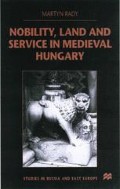Abstract
The term ‘noble’ held several consecutive meanings in medieval Hungary. To begin with, in the eleventh and twelfth centuries, it meant a member of the small group of leading men and office-holders who gathered around the person of the ruler: the proceres, principes and iobagiones regales. Then, in the thirteenth century, the description broadened to encompass the many royal servientes thrown up by the disintegration of the old castle system of administration. The servientes’ relationship to the ruler was expressed in terms of tldelitas and the personal service which they were expected to discharge. From no later than the mid-twelfth century, and right through until well into the fourteenth, a nobleman might also be one who claimed membership of an ancestral kindred and who referred to himself as the scion of a genus. This association of status with ancestry is responsible for the Hungarian word for a nobleman, nemes, which itself derives from the Hungarian nem meaning a family or kindred. During the fourteenth century, however, the term nobilis was gradually understood as meaning a landowner or, to use the contemporary term, a homo possessionatus.
Access this chapter
Tax calculation will be finalised at checkout
Purchases are for personal use only
Preview
Unable to display preview. Download preview PDF.
Abstract
Perry Anderson, Lineages of the Absolutist State, London and New York, 1979, p. 223.
George Schöpflin, Politics in Eastern Europe, London and Cambridge, MA, 1993, p. 11.
Susan Reynolds, Fiefs and Vassals: The Medieval Evidence Reinterpreted, Oxford, 1994, p. 478.
Author information
Authors and Affiliations
Copyright information
© 2000 Martyn Rady
About this chapter
Cite this chapter
Rady, M. (2000). Introduction. In: Nobility, Land and Service in Medieval Hungary. Studies in Russia and East Europe. Palgrave Macmillan, London. https://doi.org/10.1057/9780333985342_1
Download citation
DOI: https://doi.org/10.1057/9780333985342_1
Publisher Name: Palgrave Macmillan, London
Print ISBN: 978-1-349-42076-6
Online ISBN: 978-0-333-98534-2
eBook Packages: Palgrave History CollectionHistory (R0)

